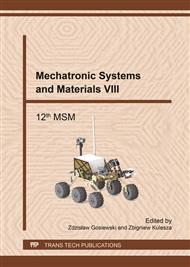p.85
p.92
p.99
p.105
p.113
p.127
p.132
p.140
p.147
Measurement and Control System for Analysis of the Operation of the Stepper Motor
Abstract:
The paper describes a control and measurement system for controlling and analysing operation of a stepper motor. The system design is based on the concept of virtual instrument, where data acquisition and transmission use standard solutions, whereas software serves both as a generator and a measurement system – an oscilloscope. The generator allows efficient control of motor operation in the following control modes: wave, full-step and half-step control. There were no winding powering sequence errors observed. The measurement system allows presenting and analysing voltage waveforms in individual windings with possibility to detect couplings and overvoltages. It was also shown that it is possible to detect locking of rotor rotation.The proposed virtual instruments have open structure, which enables extended analysis based on available measurements or expand range of measurements as long as measurement and control system instrumentation allows that.
Info:
Periodical:
Pages:
113-126
Citation:
Online since:
July 2017
Authors:
Keywords:
Price:
Сopyright:
© 2017 Trans Tech Publications Ltd. All Rights Reserved
Share:
Citation:


